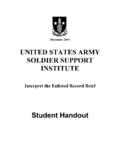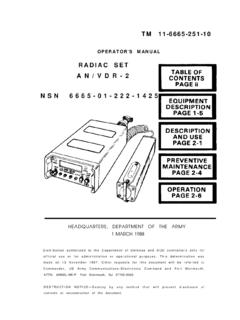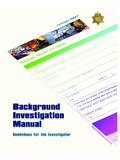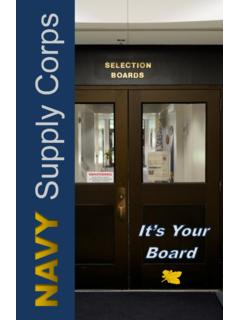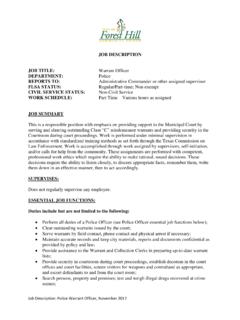Transcription of Individuals Officers’ Guide to the Officer Record Brief
1 Department of the Army Pamphlet 640 1. Personnel Records and Identification of Individuals Officers' Guide to the Officer Record Brief Headquarters Department of the Army Washington, DC. 1 April 1987. UNCLASSIFIED. SUMMARY of CHANGE. DA PAM 640 1. Officers' Guide to the Officer Record Brief o o RESERVED. FOREWORD. This pamphlet is designed to help you, the active Army Officer , understand the data displayed on the Officer Record Brief (ORB). The ORB is an important tool used in the management of officers. Therefore, the accuracy of ORB data and our understanding of its meanings is important. You, as an Army Officer , have a key role to play in ensuring your ORB correctly describes you and your accomplishments. This Guide is designed to be an easy to use reference that will answer most of your questions.
2 Of course, a pamphlet of this nature cannot contain the answer to every possible question. However, should you need more detailed information, this Guide will tell you where to find the answer. Headquarters *Department of the Army Department of the Army Pamphlet 640 1. Washington, DC. 1 April 1987. Personnel Records and Identification of Individuals Officers' Guide to the Officer Record Brief Army electronic publishing database. No are authenticated by The Adjutant Gener- content has been changed. al. Users will destroy interim changes on Summary. Not applicable. their expiration dates unless sooner super- Applicability. This pamphlet applies to seded or rescinded. the Active Army. Proponent and exception authority. Suggested Improvements. Users are The proponent agency of this pamphlet is invited to send comments and suggested the Army Military Personnel Center.
3 Improvements on DA Form 20-28 (Rec- ommended Changes to Publications and Impact on New Manning System. Blank Forms) directly to HQDA(DAPC- This pamphlet does not contain infor- OPZ-IM), ALEX VA 22332-0400. mation that affects the New Manning System. This pamphlet does, howev- er, provide an explanation of how Distribution. Active Army: To be distrib- regimental affiliation is indicated in uted in accordance with DA Form 12-9A. section X Remarks of the Officer requirements for Personnel Records and H i s t o r y . T h i s p u b l i c a t i o n h a s b e e n Record Brief (ORB). Identification of Individuals B. reorganized to make it compatible with the Interim changes. Interim changes to this pamphlet are not official unless they Contents (Listed by paragraph and page number). Section I.
4 General, page 1. Purpose 1, page 1. References 2, page 1. What it is 3, page 1. How it is used 4, page 1. How it is updated 5, page 1. How to get to see your ORB 6, page 1. How to correct your ORB 7, page 1. Section II. Officer Record Brief Data Description, page 2. Data element descriptions 8, page 2. Heading 9, page 2. Section I Assignment information 10, page 3. Section II Security Data 11, page 7. Section III Service Data 12, page 8. Section IV Personal/family data 13, page 10. Section V Foreign Language 14, page 10. Section VI Military Education 15, page 11. Section VII Civilian Education 16, page 11. Section VIII Awards and Decorations 17, page 12. Section IX Assignment History 18, page 12. *This pamphlet supersedes DA Pamphlet 640-1, 15 January 1984. DA PAM 640 1 1 April 1987 i UNCLASSIFIED.
5 Contents Continued Section X Remarks 19, page 13. Table List Table 1: Officer Branch Codes (Code 9, AR 680-29), page 2. Table 2: Tour Completion Status Codes, page 4. Table 3: Branch Numerical Code, page 4. Table 4: Functional Area Code, page 5. Table 5: FAO Geopgraphical Area Codes, page 6. Table 6: Pilot Status Codes, page 7. Table 7: Pilot Qualification in Codes, page 7. Table 8: Source of Original Appointment Codes, page 9. Table 9: Type of Original Appointment Codes, page 9. Table 10: Current Service Agreement Codes, page 9. Table 11: Language Proficiency Codes, page 10. Table 12: Military Education Level Codes, page 11. Table 13: Civilian Education Level Codes, page 12. Table 14: Source of Degree Codes, page 12. ii DA PAM 640 1 1 April 1987. Section I. General 1. Purpose This pamphlet explains to you, the active duty Army Officer , what you should know about the Officer Record Brief : what it is, its importance to you, how to correct it, and what each data element describes.
6 The objective is an Officer corps better able to interpret what ORB data represents and better able to identify and correct any errors or omissions on their own ORB. 2. References Related publications are listed below. a. AR 601-110 (Identification of Commissioned and Warrant Officer Personnel by Army Procurement Program). b. AR 611-101 (Commissioned Officer Classification System). c. AR 611-112 (Manual of Warrant Officer Military Occupational Specialties). d. AR 640-2-1 (Personnel Qualification Records). e. AR 680-29 (Military Personnel, Organization, and Type of Transaction Codes). f. DA Pam 600-3 (Commissioned Officer Professional Development and Utilization). g. DA Pam 600-8 (Military Personnel Management and Administrative Procedures). h. DA Pam 600-8-1 (SIDPERS Unit Level Procedures).
7 I. DA Pam 600-8-2 (SIDPERS Military Personnel Office Level Procedures). 3. What it is The ORB is a one page Army form designed to provide a summary of your qualifications and career history. The ORB. is produced from data stored on the Officer Master File (OMF) at the US Army Military Personnel Center (MILPER- CEN). This is a dynamic file which is updated frequently with new information. Consequently, each ORB is a snapshot of the OMF as it was at the time the ORB was produced. The ORB may be produced on paper, microfiche, or on a computer terminal display screen. 4. How it is used The ORB is used by personnel managers at HQDA and in the field. HQDA selection board members use the ORB to grain an initial impression of an Officer 's qualifications and career history and as a road map to the Officer Evaluation Reports (OER) and other documents in the Performance Section of the microfiche Official Military Personnel File (OMPF).
8 Other Individuals also use the ORB to form an image of the Officer 's experience and qualifications. Both at HQDA and in field commands, the ORB is one of the primary management tools used in determining where to assign officers. 5. How it is updated Most of the data on the ORB records events concerning your military career. Most of these events are routinely reported by your unit or Personnel Service Center/Company (PSC) and sent to MILPERCEN via the Standard Installation/Division Personnel System (SIDPERS) to the OMF. Other ORB data, for example designation of a functional area, are input to theOMF by various HQDA offices. And finally, there are certain personal items which you must report to the PSC for subsequent reporting to MILPERCEN. Examples include a change in religious preference, marital status or number of dependents.
9 6. How to get to see your ORB. a. At your PSC. Three times a year (birth month, birth month plus four months, birth month plus eight months). MILPERCEN sends a new ORB to your PSC for maintenance. The PSC keeps the most current ORB plus copies of all changes submitted which are not yet on the ORB. You, the Officer , are required to audit your birth month ORB, annotate corrections, and provide your signature and review date. Submission or certification of information known to be false or inaccurate constitutes violation of Article 107, Uniform Code of Military Justice (UCMJ). b. From HDQA. You may obtain a copy of your ORB directly from HDQA. Send a written request which includes your name, your grade, SSN, branch/functional area/MOS, mailing address, and signature to HQDA (ASNI-SMC), ALEX, VA, 22332-0400.
10 7. How to correct your ORB. a. Check carefully, item by item, a current edition of your ORB (the production month is in the upper left heading). Be sure you understand each item. Refer to part 11 of this pamphlet for item explanations. Be alert for both incorrect data and for omissions. Remember that the ORB reflects the OMF as of the production data; newly reported items will appear on ORB's which are produced after the new data has been posted to the OMF. DA PAM 640 1 1 April 1987 1. b. Errors, omissions, or new changes should be reported promptly to your PSC. Report changes when they occur; do not save your changes for annual audits. c. The PSC will, depending upon the data involved, submit a SIDPERS transaction or send a letter to the appropriate HQDA office to update the OMF.
